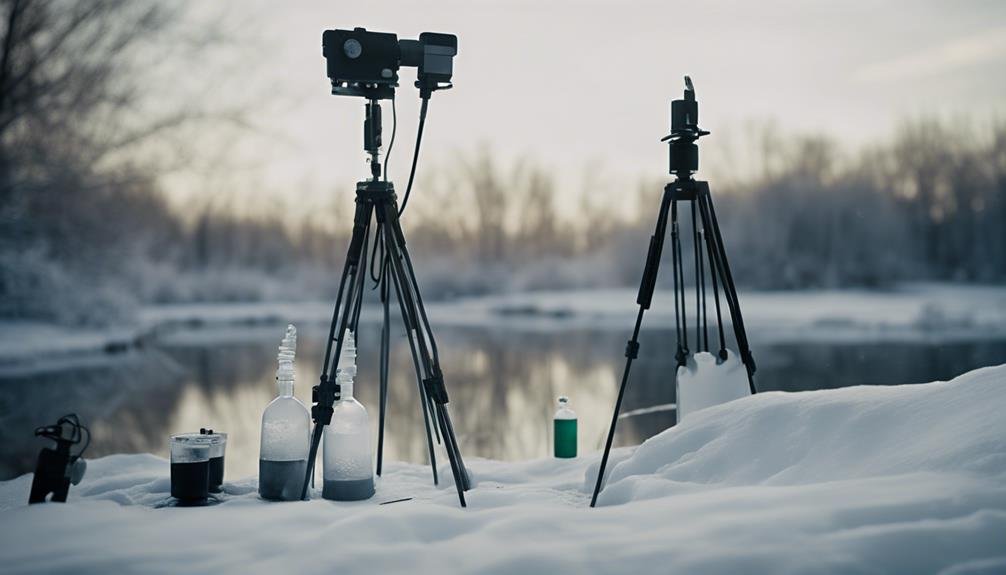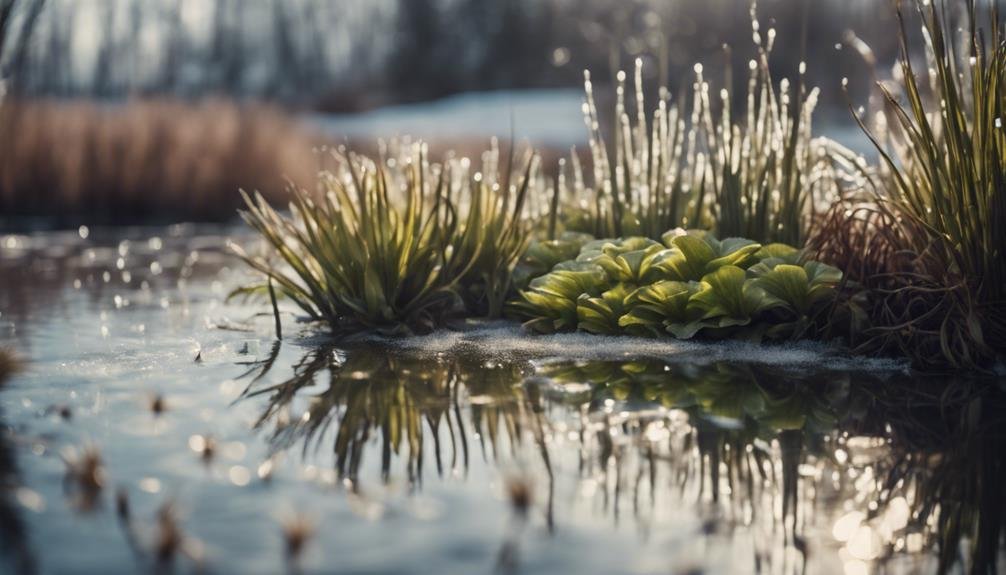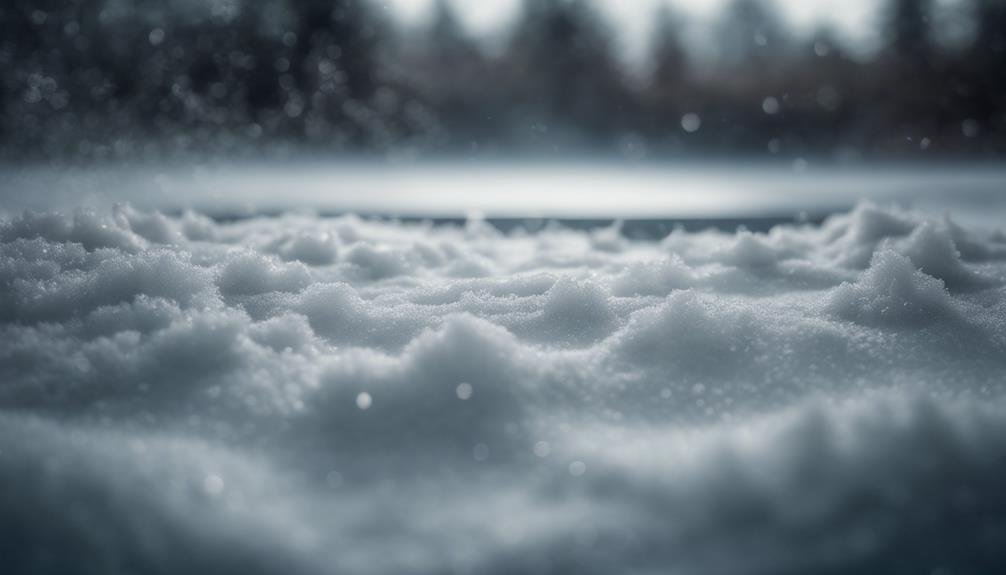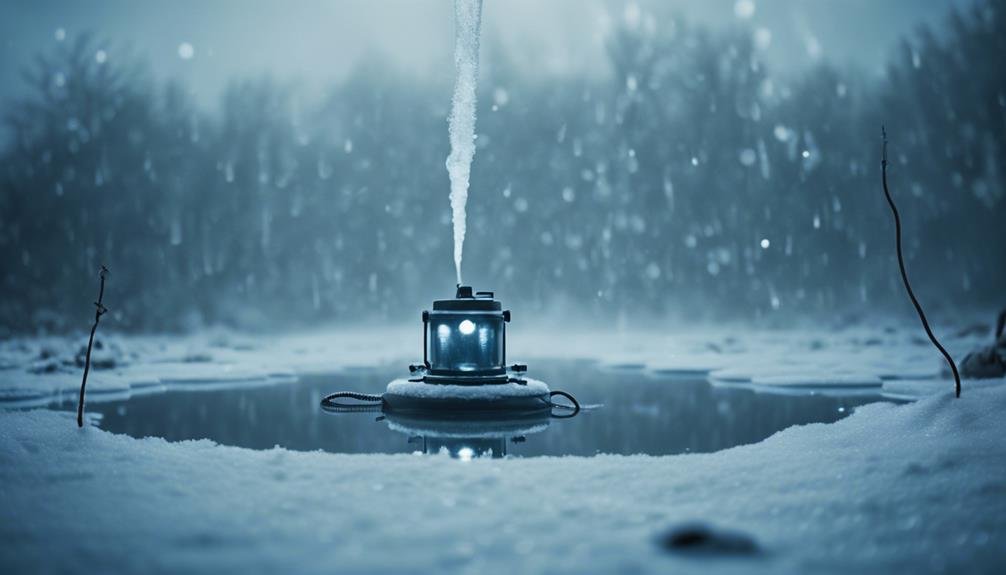To maintain a healthy pond during winter, it's crucial to invest in de-icers or aerators. These devices prevent ice formation on the water surface, ensuring proper gas exchange. Quality aerators help circulate oxygen, while de-icers create openings to prevent toxic gas buildup. Monitoring key water parameters like dissolved oxygen, pH levels, ammonia, and nitrites is essential for creating an ideal environment. Using specialized winter fish foods tailored to cold-weather nutritional requirements is important for the well-being of aquatic life.
Additionally, protecting plants in the pond is vital for their survival during winter. This includes trimming dead growth and insulating tropical plants to help them withstand the cold. Properly sizing de-icers based on the pond's dimensions is necessary to ensure effective ice prevention. Setting up heating systems following manufacturer instructions further optimizes the pond's ecosystem.
Regularly observing the activity levels of aquatic inhabitants can signal if any adjustments are needed to maintain their habitat. By following these guidelines and investing in the right equipment, you can ensure a thriving pond throughout the winter season.
Ice-Free Water Surface
Keeping a pond's surface ice-free in winter is essential for maintaining a healthy environment for aquatic life. It allows for proper gas exchange, ensuring oxygen can enter the water while harmful gases like carbon dioxide can escape. This prevents the accumulation of toxic gases under the ice that can be deadly to fish and other aquatic creatures.
To achieve this, using a reliable de-icer or aerator system is crucial. De-icers use heating elements to melt a hole in the ice, while aerators keep the water circulating to prevent freezing and add oxygen. When selecting a de-icer or aerator, consider factors like pond size, depth, and the number of fish to choose the right model.
Avoid using salt or chemical melters, as they can harm aquatic life. Opt for a pond de-icer specifically designed for this purpose, ensuring it fits your pond's size.
Proper Aeration Tools
Choosing the right aeration tools is crucial for maintaining a healthy pond environment during the winter months. Good quality aerators and diffusers are essential to ensure proper oxygen levels and prevent water stagnation.
De-icers are also necessary to create openings in the ice cover, allowing for gas exchange and preventing the accumulation of harmful gases like methane.
In ponds with fish, it's important to invest in strong aerators or air pumps that can generate sufficient water movement and aeration. These devices help circulate oxygen-rich water from the surface down to where the fish are located.
Connecting diffusers to air pumps releases a steady stream of bubbles, effectively aerating the water. It's important to choose diffusers that are suitable for the depth and size of the pond.
For water gardens without fish, simpler aeration tools like floating aerators or submerged airstones can be used. These tools introduce oxygen into the water without creating excessive currents that may disturb delicate plants.
Regardless of the type of pond, high-quality aeration equipment is essential for maintaining a balanced aquatic ecosystem throughout the winter season.
Water Quality Monitoring

To ensure the well-being of pond life during winter, it's crucial to not only maintain proper aeration but also regularly monitor key water quality parameters. Ideal water quality is vital for the health and survival of aquatic organisms in the pond.
There are three main factors to focus on:
Firstly, monitoring Dissolved Oxygen Levels is essential, especially in winter when ice cover can limit oxygen exchange. Investing in a reliable dissolved oxygen test kit and aiming for levels above 5 mg/L can help ensure sufficient oxygen for the pond inhabitants.
Secondly, keeping an eye on pH Levels is important, as fish and other aquatic creatures thrive within a specific pH range of 6.5 to 8.5. Fluctuations outside this range can cause stress to the pond life. Regularly testing the pH levels using a pH test kit will allow for adjustments to be made as needed.
Lastly, monitoring Ammonia and Nitrite Levels is crucial to prevent toxicity in the pond. Accumulation of waste from fish and organic matter can lead to increased levels of harmful substances. Conducting regular tests and performing partial water changes can help control and reduce these levels, ensuring a healthier environment for the pond inhabitants.
Winter Fish Food
Feeding fish in winter is crucial to their survival as the temperature drops. Switching to winter fish food when the water is below 50°F is essential. This type of food contains more wheat germ, which is easier for fish to digest when their metabolism slows down.
Once the water temperature falls below 39°F, it's best to stop feeding the fish. At this point, their digestive systems are too sluggish to process the food properly, leading to water pollution from uneaten food.
Resuming regular feedings in early spring, when temperatures rise above 50°F, is vital for the fish's health. Following the instructions on winter fish food carefully is crucial to avoid overfeeding, which can harm the fish and water quality. It's important to feed the fish the recommended portions based on their size and number to prevent waste buildup under the ice.
Pond Plant Protection

Caring for pond plants in winter is just as crucial as looking after fish. While hardy aquatic plants can handle the cold, it's important to take extra steps to protect them.
To ensure their survival, follow these essential tips:
First, trim and remove any dead foliage to prevent decay, which can harm the pond water's oxygen levels.
For tropical or marginally hardy plants, insulate their root systems with burlap wraps or styrofoam covers to provide warmth. Avoid letting ice form directly over the plants, as it can cause damage.
Consider using a pond de-icer or installing an aeration system to keep a section of the pond ice-free.
Snow Removal Equipment
When it comes to taking care of a pond in winter, having the right snow removal equipment is essential to ensure access and prevent snow buildup. To begin, a sturdy snow shovel or pusher is necessary to clear pathways leading to the pond. Opt for a plastic shovel with a curved blade that can easily scoop and throw snow without causing damage to surrounding areas.
For larger snow-covered areas around the pond, a snow blower can be a valuable tool. While gas-powered models provide more power for heavy snow, electric options are quieter and more environmentally friendly. It's important to be cautious when using a snow blower near the water to avoid discharging snow directly into the pond, which could disrupt the pond's delicate ecosystem.
Having the right snow removal equipment not only makes maintenance easier but also ensures the pond remains accessible and safe during the winter months. Consider investing in quality tools like a durable snow shovel, a reliable snow blower, and always prioritize the protection of the pond's ecosystem when clearing snow in the vicinity.
Insulating Pond Covers

Insulating pond covers are essential for maintaining ideal water temperatures during the winter months, preventing complete freeze-overs, and creating a suitable environment for aquatic life. These covers serve multiple purposes: they trap heat from the sun, reduce water evaporation, and act as a physical barrier against debris and wildlife.
There are different materials available for insulating pond covers, such as foam boards or plastic sheets. It's important to choose covers that are lightweight yet durable enough to withstand snow loads. These covers are custom-cut to fit the surface area of the pond and secured around the edges with weights or clips.
While rigid foam board covers offer superior insulation, pond netting covered with plastic sheeting can also create an air pocket that serves as a decent insulator. It's crucial to leave an opening for gas exchange and periodically check under the cover to ensure everything is in order.
Automatic De-Icers
Automatic de-icers are a great addition to insulating pond covers, ensuring parts of the pond's surface stay free of ice during freezing weather. Placing these devices strategically is crucial to create breathing holes and maintain proper gas exchange, which is essential for the well-being of fish and other pond inhabitants in winter.
These de-icers function by gently heating a small area to prevent water from freezing. You can choose between floating or submersible models. Floating de-icers sit on the surface, while submersible ones are attached to the pond floor. Most models have a thermostatically controlled heating element that only kicks in when temperatures fall below a certain point, helping to save energy.
Properly sizing the de-icer based on the pond's surface area and depth is key. Factors like water flow, aquatic life present, and the local climate also play a role in determining the right size needed.
It's advisable to follow the manufacturer's recommendations and consider opting for a slightly larger unit than the minimum suggested to ensure it can effectively keep an area ice-free, even in extremely cold conditions.
Heating System Setup

Setting up a heating system is crucial for maintaining consistent water temperatures in your pond during the winter months. This ensures the well-being of your fish and plants.
To get started, gather a submersible pond de-icer or water heater that fits the size of your pond, along with durable outdoor extension cords and a ground fault circuit interrupter (GFCI) for safety.
Follow the manufacturer's instructions carefully when installing the heating system. Begin by placing the de-icer or heater in the deepest part of the pond, away from the edges. Secure the cords with waterproof connectors to prevent them from coming loose accidentally. Plug the GFCI into a grounded outdoor outlet, and then connect the de-icer to the GFCI.
Properly adjusting the thermostat is essential for efficient operation. Avoid overheating, as it wastes energy and can harm wildlife. On the other hand, underheating may lead to ice damage.
A well-maintained heating system strikes a balance between preventing freezing and conserving energy, creating a healthy winter environment for your pond ecosystem to thrive.
Aquatic Life Monitoring
In addition to maintaining the right water temperature, it's crucial to regularly check on the health of the aquatic life in our pond during winter. Observing the activity levels and behavior of our fish and other inhabitants is key, as changes in these aspects could indicate potential issues. For instance, a decrease in movement or appetite might be a sign of distress or illness.
Monitoring water quality parameters such as pH, ammonia, and nitrite levels is also essential. Fluctuations in these values can have harmful effects on the fish, plants, and other aquatic species in our pond. Here's a breakdown of the potential consequences of imbalanced water conditions:
- pH: Acid Burn (if too low) or Ammonia Toxicity (if too high)
- Ammonia: Gill Damage (if too high)
- Nitrite: Blood Issues (if too high)
Regular testing and adjustments of these levels through water changes or appropriate treatments are necessary to ensure a healthy winter ecosystem for our aquatic friends.
Conclusion
By ensuring proper aeration, heating, de-icing, and plant protection, we can ensure that our aquatic friends thrive even in the coldest of temperatures. Monitoring water quality and providing the right food for our fish will keep them healthy and happy throughout the winter, so they'll be ready to greet us when spring arrives.
This is a crucial time to care for our ponds, as the cold weather can pose challenges for aquatic life. Implementing these measures will help maintain a balanced ecosystem and ensure that our pond remains a vibrant and lively space.
Additionally, investing in quality products such as aeration pumps, pond heaters, de-icers, and fish food specific for cold weather can make a significant difference in the well-being of our pond inhabitants. So, let's gear up for winter pond maintenance and keep our aquatic environment flourishing all season long.

